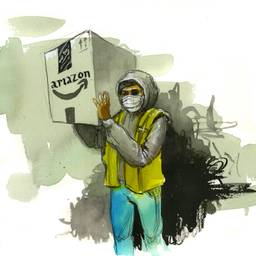This Amazon Grocery Runner Has Risked Her Job to Fight for Better Safety Measures
Courtenay Brown knows she could be on the streets if she loses her job at an Amazon Fresh unit. She’s speaking out about scant Covid-19 safety measures and lack of workplace benefits anyway.
Michelle Chen and Molly Crabapple

This article is part of a series on Amazon workers produced in partnership with the Economic Hardship Reporting Project.
Courtenay Brown spends her day making grocery runs for others in a football-field-sized maze of narrow aisles and refrigerated enclaves. At the Amazon Fresh unit in a Newark, New Jersey fulfillment center, she works on the outbound ship dock, helping direct the loading of trucks and send them off on local delivery routes. Brown says that after nearly three years at the e-tail empire, her job has been “hell.”
“Imagine a really intense workout, like you just got off of the treadmill, no cool down, no nothing,” she describes one especially grueling day with a resigned laugh. “That’s how my legs felt.”
Amazon Fresh employees often have to comb through huge stocks of various chilled and frozen items, which means they need to wear full winter clothes to work. The stress and physical exhaustion of the job tends to wear out many new hires within their first few days. “You don’t have that many that have lasted here,” she says. “It’s so hard.”
With the pandemic keeping consumers indoors, Amazon grocery sales have roughly tripled in the second quarter over last year. The number of delivery trucks moving in and out of the Newark fulfillment center has jumped accordingly.
“Every day I come in, it’s just more and more and more and more,” Brown says. “Literally every day we break the previous day’s record for the total number of routes that went out for the entire day.”
“Once we get home [from work], the only thing we can do is shower and disinfect,” she continues. “A lot of us [are] too exhausted to eat. We pass out. Then we repeat the process the following day.” Some coworkers have ended up oversleeping, she adds, and “end up missing the whole day.”
For its part, an Amazon spokesperson wrote in an email that while some jobs at Amazon Fresh are physically taxing, workers can choose less strenuous labor.
“Imagine your standard normal supermarket aisle, [then] cut that in half,” she observes. “You’re expected to go through that aisle with other people stocking the shelves, or cleaning… it’s really, really, really cramped.”
Amazon boasts making 150 operational changes during the pandemic that include distributing millions of masks at worksites, adding thousands of janitorial staff, and redeploying some personnel to help enforce social distancing rules. While it has implemented social-distancing rules, and even provides an electronic monitoring system to help keep workers several feet apart on the warehouse floor, Brown says work spaces are still too crowded: “It’s pretty much a show…Where I work on the ship dock, we’re all mashed up together.”
The tense atmosphere has “definitely changed the relationship” among workers, she contends. Her fellow employees were friendlier before, but now “a lot of people snap at each other a bit more.”
The threat of COVID-19 has only added to the psychological burden. “When the pandemic first started, I remember a lot of us were watching the news,” Brown reflects. “I was talking to managers and trying to get them [to listen]. ‘Hey, you know, this is going on and we might want to start preparing.’ And they [were] just [acting] like it [was] not that big of a deal. People are dying, and it’s not that big of a deal?”
Although Amazon eventually enacted safety measures, Brown says she and her colleagues spent “months complaining” about what they saw as substandard protections, including inadequate safety gear and social-distancing measures. An Amazon spokesperson maintains the company moved to protect its workers at the outset of the pandemic, and that masks were distributed in early April.
But Brown bristles at the company’s claims, saying the response was slow and devoid of transparency. Workers were especially upset, she recalls, when they received news of a COVID-19 infection at their site two weeks after the individual had reportedly taken ill.
Eventually, Brown connected with other Amazon organizers through an online petition circulated by the advocacy network United for Respect. Earlier this year, she began working with the Athena coalition to pressure Amazon to reinstate some worker protections that were instituted earlier on in the pandemic and then discontinued. The workers are demanding the restoration of “hazard pay” for fulfillment-center workers, as well as unlimited unpaid leave for those who opt to stay home to protect their health. (Over the objections of its workforce, Amazon ended unlimited unpaid leave and scrapped its $2 hourly “incentive” bonus in May.) The coalition is also pushing for more transparency in the reporting of new cases, so management will “actually tell us the truth about the numbers of people that are sick.”
In April, Brown participated in a media conference call with Sen. Cory Booker, D-N.J., to promote an Essential Workers Bill of Rights that would beef up health and safety protections, provide childcare support and universal paid leave policies, and protect whistleblowers. More recently, she was featured in a New York Times video about the working conditions at Amazon. She claims her public campaigning has drawn the ire of management.
“I’m harassed every day, all day,” she says. One safety supervisor in particular is “just watching” to see if she violates the company’s social-distancing rules.
Brown recalls a recent incident in which she was speaking casually with some co-workers about safety issues when the supervisor intervened, shouting at them to keep six feet apart. Although they were all maintaining their distance, she says, “he [yelled], ‘you’re in a group!’” They answered, “Yeah, but we’re all six feet apart from each other with our masks on.” But she says the manager nonetheless threatened to write them up and warned they could be terminated.
Amazon has stated that it opposes retaliation against employees who voice their concerns about working conditions. But like other Amazon organizers, Brown believes her treatment reflects a broader campaign aimed at dissuading employees from organizing.
“What they’ll do is they’ll find an individual, and they’ll kind of make an example of you. And that scares everybody else,” she says. Her observations are affirmed by a recent Open Markets Institute report that finds that Amazon has used sophisticated workplace surveillance tactics to intimidate and suppress workers who seek to unionize or challenge the company’s labor practices.
Amazon has denied charges of employee surveillance, dismissing the Open Markets Institute as “a perennial critic that willfully ignores” the company’s record of creating jobs with “industry leading wages and benefits.” The company claims that it does evaluate workers’ performance “over a long period of time,” and provides under-performing workers with “dedicated coaching to help them improve.”
Brown, meanwhile, is dedicated to improving her workplace. This is not the first time she has faced hostile circumstances, both inside the Amazon warehouse and out. For a stretch in 2018, she had to live in a motel with her sister, who also works at Amazon, because the two could not secure a rental apartment with the wages they were earning delivering food for the corporate behemoth. “We were literally starving,” she says. “We weren’t making enough to be able to pay for the room, eat, and make it to and from work.”
Given the dangers of speaking out, Brown sometimes wonders if she might end up homeless again. But she’s less fearful about losing her job than she is about the health hazards she faces every day as she fights to hold her employer accountable. “It’s really terrifying,” she says, “but if I don’t do this, then I could potentially get sick and die.”
Michelle Chen is a contributing writer at In These Times and The Nation, a contributing editor at Dissent and a co-producer of the “Belabored” podcast. She studies history at the CUNY Graduate Center. She tweets at @meeshellchen.
Molly Crabapple, an artist and writer in New York, is the author of, most recently, Drawing Blood and Brothers of the Gun, (with Marwan Hisham). Her art is in the permanent collections of the Museum of Modern Art. Her animated short, A Message from the Future with Alexandria Ocasio-Cortez, has been nominated for a 2020 Emmy for Outstanding News Analysis: Editorial and Opinion.













